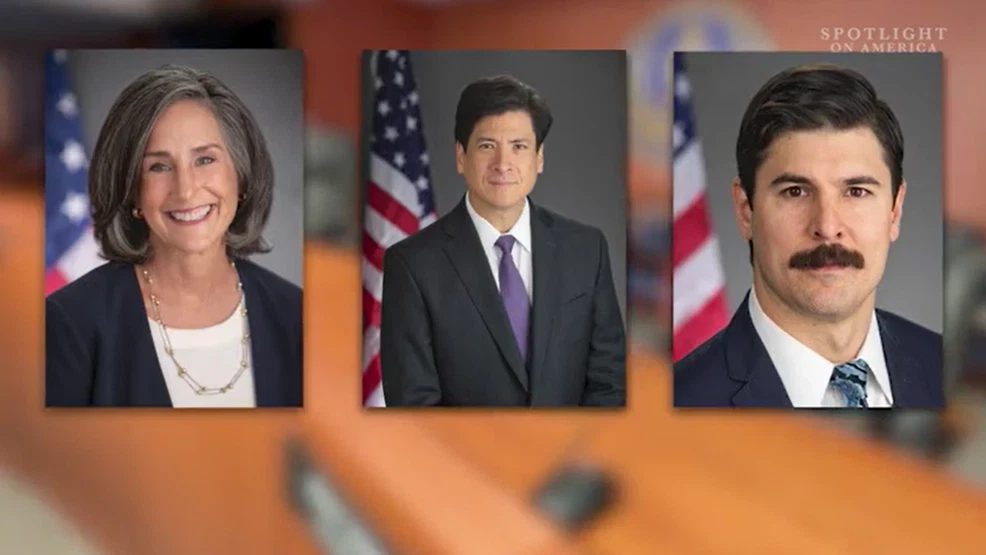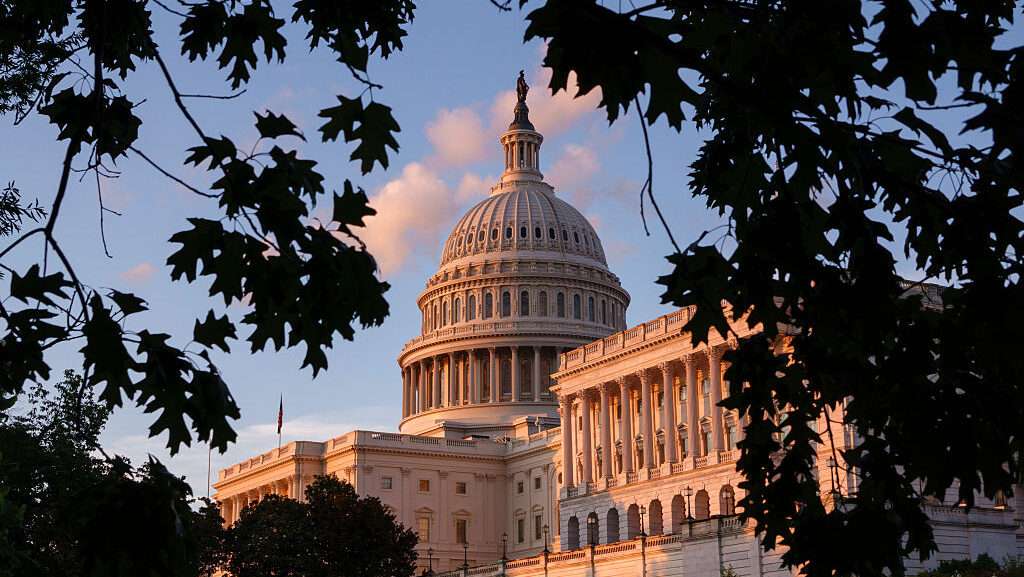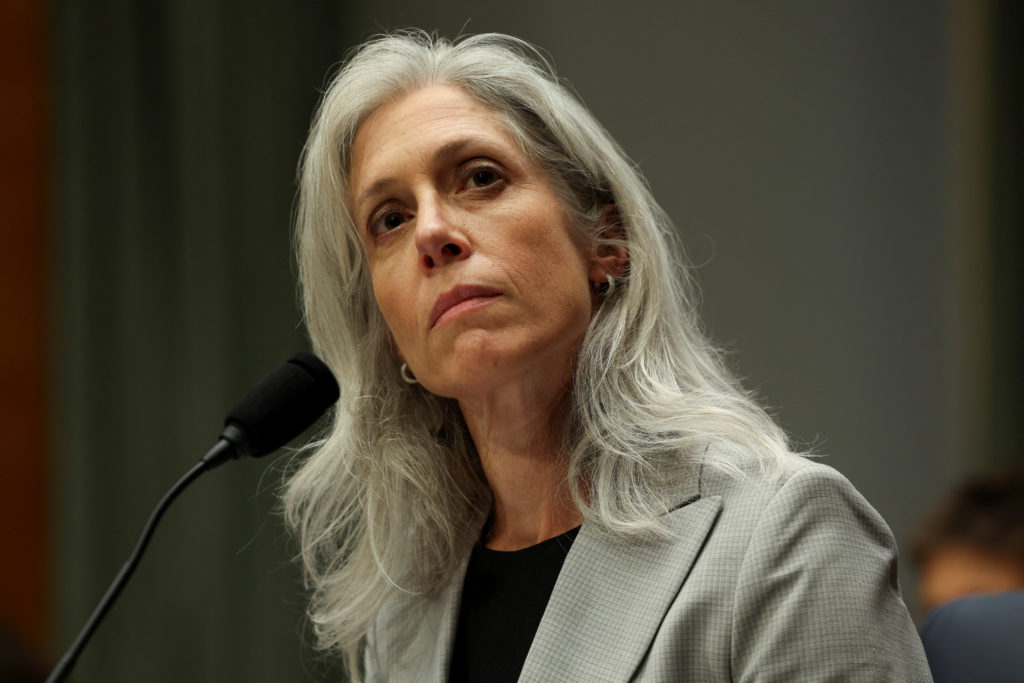
The future of consumer product safety in America is in a state of flux, as major changes rock the agency tasked with protecting the public from dangerous products. It’s now down to just one man making decisions about dangerous products, after three democratic commissioners were fired and one republican resigned. Spotlight on America National Investigative Correspondent Angie Moreschi is working to get answers on what exactly this means for product safety moving forward.
Proposed rules withdrawn
It’s a simple product used to clean out your keyboard, but aerosol dusters also lead to an estimated 100-to-200 deaths a year when the compressed air is inhaled to get high.
“It’s almost like playing roulette with this product,” Claudia Dimit told Spotlight on America. “You can inhale it first time and die.”
Dimit lost her son, Brandon, more than a decade ago, to a toxic reaction from inhaling compressed air. Just 28 years old, she says he was a successful cinematographer living near Los Angeles, shooting music videos. She never saw it coming.
“It’s very hard to even talk about it,” she told us, choking up, as she tried to tell us what happened. “It was really shocking. He used the product for about 20 days. He had seizures, and we had to call 911. It’s really a very traumatic situation.”
A longtime high school principal, she now fights to raise awareness about the danger of so-called canned air and just how addictive it can be, especially for young people.
“The kids that inhale it think it’s a kind of party drug. A lot of them do not know how dangerous the chemical is and the aspect of what they’re doing,” she said.
As part of her crusade, Dimit petitioned the Consumer Product Safety Commission to request a new regulation for the chemicals in these products that can make them deadly.
“People are dying in every single state in the country, many thousands of deaths!” she explained.
She submitted her petition to the CPSC in 2021 and was glad to see it , but this August, the proposed rulemaking was .
Shake-up at the CPSC
The aerosol duster rule was upended after a shake-up at the CPSC, when the Trump administration fired the three Democratic commissioners on the board.
“I actually cried, “Yeah, it’s aaah,” Dimit said, choking up as she shared her reaction to the aerosol duster rulemaking being withdrawn. “All of a sudden they took four years’ worth of research and just threw it out the window.”
Other proposed rules for recreational off-highway vehicles and table saws were .
CPSC acting chairman Peter Feldman, a Republican, is now the only remaining commissioner.
He declined to do an interview with Spotlight on America, but the CPSC put out a statement saying the withdrawn rules “fail to advance safety.”
The statement also indicated the withdrawn rules “no longer align with the agency’s priorities,” saying:
“This move signals a fundamental shift under CPSC’s new leadership to focus [on] sound science, robust data, and common sense. Going forward, the Commission will act where mandatory standards are truly necessary and the evidence shows federal intervention will meaningfully advance safety.”
Consumer advocates question CPSC action
“What evidence do you have that justified these actions?” asked Daniel Greene, Senior Director of Consumer Protection & Product Safety at the National Consumers League.
Greene disputes the commission statement, claiming the withdrawn rules failed to advance safety.
“The rulemakings they withdrew had substantial evidence in terms of fatalities and injuries,” he told Spotlight. “Ultimately, it’s going to lead to more unnecessary injuries and unnecessary deaths.”
The National Consumers League, along with 100 other product safety advocates , expressing concern that the CPSC is moving in a more ideological direction, that will undermine its safety mission, noting that the CPSC was created by Congress during the Nixon administration, “as an independent federal agency led by five bipartisan Commissioners.”
“I fear that this agency is not going to be necessarily guided by mission to protect consumers and promote safety but is really going to be focused on deregulation,” Greene said.
New safety rules announced
At its fiscal 2026 priorities hearing, the CPSC did, however, announce two new safety rules for infant and .
“I’m thankful that they were able to get the water bead rule out,” safety advocate and mom Ashley Haugen told Spotlight.
She founded the website after her daughter Kipley, now 9 years old, was seriously injured after accidentally swallowing water beads as a toddler.
“Yeeess! Very, very, very, very excited.” Kipley cheered, when we asked her reaction to passage of the new water beads rule. “I hope no more children get hurt by water beads.”
The tiny polymer beads grow into squishy balls when liquid is added, and , have caused multiple injuries and deaths among small children who can suffer intestinal blockages and even toxic brain damage when they are ingested.
For Ashley and Kipley, the new regulation for water bead toys was a long, hard-fought win.
“It’s an amazing victory. It means that kids won’t be able to get these as toys anymore in the United States,” Ashley said.
Bittersweet Victory
Ashely calls the win bittersweet, though, because it took so many children to be harmed before the final rule was passed. She and Kipley wore watermelon-themed shirts for the interview in honor of 10-month-old Esther Bethard of Wisconsin, who died in July of 2023, after accidentally ingesting water beads. After her death, the CPSC finally issued a partial recall and warning about water beads.
“It’s going to protect a lot of children, and I’m thankful for that,” she said. “ I know that we’re lucky because we get to have her (Kipley), and not every family has that opportunity.”
Still, given that the CPSC finalized the water beads rule and the infant neck floats rule, after they remained in limbo for so long, she says she is hopeful.
“If they’re getting the job done, frankly, to me that’s what matters most,” she said. “I just want children to be safe.”
Why stop there?
But Greene asks: “Why stop there?” He insists there was significant evidence, based on years of research to show the need for the rulemakings that were withdrawn.
“It just doesn’t quite make sense to me as to why would you just stop with those two standards and not just finalize these other really important rulemakings,” he said.
One reason cited by the commission in a is that most neck floats and water beads are not produced in America, but in foreign countries like China.
“Today’s actions make clear the Commission’s current leadership is committed to the agency’s core mission of protecting Americans from products that can cause the most harm. These rules will also provide new tools in the broader fight against China and the Chinese Communist Party, which have demonstrated time and again that they care little for U.S. laws or the safety of American consumers. These new standards should put foreign manufacturers and importers on notice: if you want access to the U.S. market, you must meet our safety standards.”
Greene says the National Consumer League is now leading an effort by public interest groups to send a letter to the CPSC requesting that it provide more justification on rescinding the rules. He says they will ask the agency to “publicly release a reasoned explanation (including risk assessment, product testing, evaluation of relevant industry standards, review of regulatory alternatives, benefit-cost analysis, and consideration of public comments) for rescinding the guidance on the value of a statistical life and four proposed standards and bans.”
Spotlight is also taking a closer look at the other proposed rules withdrawn. Two were supposed to create more transparency to warn the public about dangerous products. We will have more on that in an upcoming report.
CPSC answers Spotlight questions
Meantime, while acting CPSC commissioner Feldman would not agree to do an interview with Spotlight, a spokesperson answered some of our written questions. You can read the answers below:
What CPSC work is continuing to ensure that American citizens are protected against dangerous products? CPSC is currently drafting its Operating Plan for the upcoming fiscal year that will outline intended work for 2026. The Commission anticipates no interruptions in its efforts to protect the public. CPSC’s core mission remains to protect American families from the unreasonable risk of injury associated with consumer products. The agency is using the full weight of its executive authority to identify and notify American families about products that put their families in danger.
What are the CPSC’s priorities moving into Fiscal Year 2026? While CPSC has not finalized its Operating Plan for 2026, please refer to the comments of the Acting Chairman and Executive Director at the August 27, 2025, priorities hearing, available here. The testimony CPSC received for that hearing will inform the 2026 plan. In several important instances, the Commission has already advanced stakeholder priorities, including on water beads and neck floats.
Will the public database at saferproducts.gov continue to be maintained? Who will compile and post the incoming products reports? What is the turnaround time to post? Yes. The turnaround time varies based on a number of factors; however, more than 95 percent of the data are entered into CPSC’s internal database within one business day of receipt.
How will new AI technology deployed help in the CPSC’s mission to protect the public against dangerous products? Among other things, CPSC will leverage AI to strengthen risk detection, hazard analysis, import surveillance and enforcement targeting. AI is central to CPSC’s strategic data initiative, enabling the Commission to process and interpret massive data sets that previously exceeded our analytical capacity. These include electronic health and injury records, commercial trade data, and retailer reports. By integrating these sources, AI will deliver real-time insights into emerging hazards, allowing CPSC to act faster and more effectively to protect consumers.
How will the 4 additional port employees hired be utilized? While we cannot discuss operationally sensitive details about asset deployments, CPSC’s port inspectors are the frontline of the Commission’s efforts to protect American families from unsafe products entering the country.
What specific data and considerations were used to make the decision to withdraw the need for rulemaking for aerosol dusters, table saws, and recreational off-highway vehicles? Please see the which sets forward the Commission’s position and rationale for these withdrawals.



